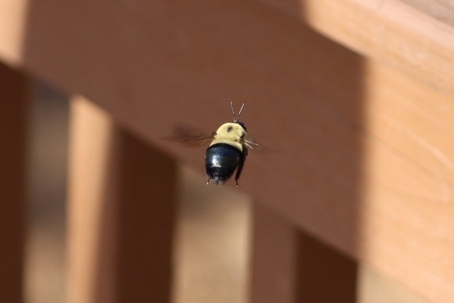Spraying For Carpenter Bees
Spraying for carpenter bees is sometimes necessary due to the significant structural damage they can cause and the difficulty of controlling infestations through passive or non-chemical means alone. While carpenter bees are solitary and not as aggressive as other bee species, they are still wood-boring insects that tunnel into exposed, unpainted, or weathered wood to create nests. Over time, this tunneling weakens wooden structures and invites moisture, decay, and secondary pest infestations. Here’s why spraying sometimes becomes necessary:
Structural Protection: Carpenter bees bore perfectly round holes into wood, creating tunnels that can extend several inches or more. Multiple bees nesting in the same area—or the same bee reusing and expanding an existing tunnel—can lead to cumulative damage over time. This is especially problematic in untreated or decorative wood like fascia boards, soffits, railings, eaves, decks, pergolas, and fences. If left unchecked, this damage may compromise the integrity of these components.
Safety Considerations: Though carpenter bees are not highly aggressive, males will often hover and “dive bomb” perceived threats, which can be alarming to residents and visitors. Female carpenter bees are capable of stinging if provoked. In heavily infested areas, this can create a nuisance and elevate the risk of stings, particularly for people with bee allergies or small children.
Preventing Repeat Infestations: Carpenter bees tend to return to the same nesting sites year after year. If an area becomes established as a nesting zone, it will attract future generations. Spraying helps eliminate active bees and treats the wood to make it less attractive for future nesting. When paired with wood sealing or painting, it can break the cycle of re-infestation.
Control of Secondary Pests: Abandoned carpenter bee tunnels often attract other pests such as carpenter ants, beetles, or rodents. These secondary pests can further the damage and complicate control efforts. Early intervention using residual insecticides can help prevent this cascading effect.
- Limited Effectiveness of DIY Methods: While non-chemical strategies like sealing holes, painting or staining wood, and using traps can help reduce carpenter bee activity, they often fail to fully control an established population. Spraying with a residual insecticide specifically labeled for carpenter bees provides a professional-grade solution that offers longer-lasting protection, especially when applied directly into galleries and around susceptible wood surfaces.
Carpenter Bee Repellents
Carpenter bee repellents play an important role in an integrated pest management (IPM) strategy by discouraging bees from nesting in vulnerable areas, reducing the likelihood of damage without relying solely on extermination. While they do not kill the bees, repellents help prevent initial colonization or re-infestation, especially when combined with other preventive and corrective measures. Their value lies in protecting treated wood surfaces and creating an inhospitable environment for nesting.
Here is how carpenter bee repellents help when spraying for carpenter bees:
Behavioral Disruption: Making Wood Unappealing
Carpenter bee repellents are formulated to target the bees’ natural nesting instincts. These products often contain:
Natural essential oils (such as citrus, peppermint, citronella, tea tree, or almond oil) that carpenter bees find offensive
Synthetic formulations with long-lasting residues designed to deter bees from landing or burrowing
These ingredients interfere with the bees’ sensory perception and make treated surfaces unattractive for excavation. When used early in the season, before nesting begins, repellents can dramatically reduce the number of exploratory bees settling on wood structures.
Preventing Nest Site Selection
Carpenter bees are known for their site fidelity—returning to the same locations each spring to reuse or expand previous tunnels. Repellents can disrupt this cycle by masking or overwhelming the scent markers that female carpenter bees use to identify old galleries, and creating a chemical barrier on wood surfaces that deters new nest creation
By applying repellents around eaves, fascia, decks, and other vulnerable wood features, property owners can prevent bees from ever starting the nesting process, reducing the need for reactive measures later.
Complementing Other Treatments
Repellents are most effective when integrated with other methods, including:
Physical modification: Painting, staining, or sealing wood eliminates the soft, weathered surfaces that carpenter bees prefer. Repellents provide an added layer of protection on top of these barriers.
Insecticidal treatments: In areas with a history of infestation, a combination of repellent and residual insecticide helps deter new bees while eliminating active ones.
Mechanical exclusion: Closing off existing galleries with wood filler or caulk—after treating with insecticidal dust—prevents re-entry. Repellents sprayed on these repaired surfaces help discourage re-drilling.
Monitoring and traps: Repellents reduce the chance of bees approaching, while traps help assess population levels and activity to guide further action.
Application Timing and Frequency
Effectiveness depends heavily on correct timing and consistent reapplication:
Early season (late winter to early spring): Repellents should be applied before females begin searching for nesting sites.
Reapplication: Most natural repellents degrade over time due to UV exposure and weather. They must be reapplied every few weeks, especially after rain or heavy sunlight.
High-risk areas: Focus on untreated wood, previous infestation sites, and shaded, sheltered overhangs.
Carpenter bee repellents serve as a proactive, preventive component in an integrated approach that emphasizes deterrence, habitat modification, and targeted chemical treatments only when necessary. By reducing the attractiveness of potential nesting sites, spraying repellents helps to minimize structural damage, preserve the appearance of woodwork, and reduce the need for repeated pesticide applications.

